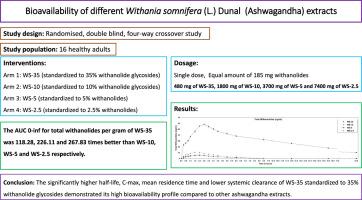随机、双盲、交叉研究比较4种印度稻(Withania somnifera)的生物利用度健康成人禁食条件下的杜纳尔提取物
IF 1.5
Q3 MEDICINE, RESEARCH & EXPERIMENTAL
Current Therapeutic Research-clinical and Experimental
Pub Date : 2025-01-01
DOI:10.1016/j.curtheres.2025.100805
引用次数: 0
摘要
背景:withania somnifera (L.)杜鹃花,通常被称为阿育吠陀,是印度草药中著名的植物,因其治疗潜力而受到广泛重视。尽管许多临床研究已经探索了其多种健康益处,但关于其关键生物活性成分在人体中的药代动力学(PK)特性和比较生物利用度的数据有限。目的评价和比较4种市售标准ashwagandha提取物在健康成人空腹条件下的口服生物利用度。方法采用随机、双盲、4治疗、4周期、4序列、单剂量、4向交叉的方法对16名健康志愿者进行研究。参与者接受单次口服剂量的4种ashwagandha提取物中的1种,其不同成分为35% (Withania somnifera [WS]-35)或10% (WS-10)的withanolides苷,或5% (WS-5)或2.5% (WS-2.5)的withanolides,每种提取物的标准含量为185 mg总withanolides。在给药后24小时内采集17份血样。测定血药浓度,并计算药代动力学参数。结果与其他提取物相比,苦参-35具有显著的生物利用度。WS-35每克总戊内酯的AUC0-t分别比WS-10、WS-5和WS-2.5高118.28倍、226.11倍和267.83倍。Withania somnifera-35表现出较高的Cmax、较长的半衰期、较长的平均停留时间和较低的全身清除率,这主要归因于其较高的Withania somnifera-35的内酯苷含量。结论这些研究结果强调了缬草内酯苷在决定缬草补剂PK性能中的关键作用。WS-35提高的生物利用度支持其优先用于治疗应用,并为进一步研究标准化、高生物利用度制剂的剂量-反应关系和长期疗效提供了强有力的理论依据。印度临床试验注册编号:CTRI/2020/10/028397。本文章由计算机程序翻译,如有差异,请以英文原文为准。

Randomized, Double-Blind, Crossover Study Comparing the Bioavailability of 4 Ashwagandha (Withania somnifera (L.) Dunal) Extracts in Healthy Adults Under Fasting Condition
Background
Withania somnifera (L.) Dunal, commonly known as ashwagandha, is a well-known plant in ayurvedic medicine, widely valued for its therapeutic potential. Although numerous clinical studies have explored its diverse health benefits, limited data are available on the pharmacokinetic (PK) properties and comparative bioavailability of its key bioactive constituents in humans.
Objective
This study aimed to evaluate and compare the oral bioavailability of 4 commercially standardized ashwagandha extracts under fasting conditions in healthy adults.
Methods
This randomized, double-blind, 4-treatment, 4-period, 4-sequence, single dose, 4-way crossover study was conducted in 16 healthy human volunteers. Participants received a single oral dose of 1 of 4 ashwagandha extracts, with varying compositions of 35% (Withania somnifera [WS]-35) or 10% (WS-10) withanolide glycosides, or 5% (WS-5) or 2.5% (WS-2.5) withanolides, each standardized to deliver 185 mg of total withanolides. Seventeen blood samples were collected over a 24-hour period after dose administration. Plasma concentrations of withanolide A, withanoside IV, withaferin A, and total withanolides were quantified, and PK parameters were calculated.
Results
Withania somnifera-35 had significantly superior bioavailability compared with the other extracts. The AUC0–t for total withanolides per gram of WS-35 was 118.28, 226.11, and 267.83 times better than WS-10, WS-5, and WS-2.5 respectively. Withania somnifera-35 exhibited a significantly higher Cmax, longer half-life, extended mean residence time, and lower systemic clearance, attributable to its higher withanolide glycoside content.
Conclusions
These findings emphasize the critical role of withanolide glycosides in determining the PK performance of ashwagandha supplements. The enhanced bioavailability of WS-35 supports its preferential use in therapeutic applications and provides a strong rationale for further investigation into dose-response relationships and the long-term efficacy of standardized, high-bioavailability formulations. Clinical Trial Registry of India identifier: CTRI/2020/10/028397.
求助全文
通过发布文献求助,成功后即可免费获取论文全文。
去求助
来源期刊
CiteScore
3.50
自引率
0.00%
发文量
31
审稿时长
3 months
期刊介绍:
We also encourage the submission of manuscripts presenting preclinical and very preliminary research that may stimulate further investigation of potentially relevant findings, as well as in-depth review articles on specific therapies or disease states, and applied health delivery or pharmacoeconomics.
CTR encourages and supports the submission of manuscripts describing:
• Interventions designed to understand or improve human health, disease treatment or disease prevention;
• Studies that focus on problems that are uncommon in resource-rich countries;
• Research that is "under-published" because of limited access to monetary resources such as English language support and Open Access fees (CTR offers deeply discounted English language editing);
• Republication of articles previously published in non-English journals (eg, evidence-based guidelines) which could be useful if translated into English;
• Preclinical and clinical product development studies that are not pursued for further investigation based upon early phase results.

 求助内容:
求助内容: 应助结果提醒方式:
应助结果提醒方式:


